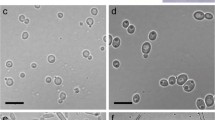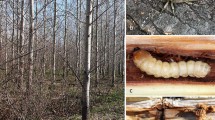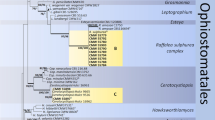Abstract
The presence of three symbiotic fungi: Fusarium euwallaceae, Graphium euwallaceae and Acremonium pembeum was detected in the larvae and adult beetles of Euwallacea nr. fornicatus (Coleoptera: Scolytinae) and from the brood galleries of four tree species. Isolations from female beetle mandibular mycangia recovered mainly G. euwallaceae and A. pembeum during adult maturation, whereas isolations from mature adult beetles revealed F. euwallaceae, almost exclusively. Only G. euwallaceae (from adults) and mostly G. euwallaceae (from larvae) were isolated from the guts of the examined beetles. Within larvae, G. euwallaceae was quantified at much higher concentrations for all the tested tree hosts, compared to F. euwallaceae and A. pembeum. Fungal mandibular mycangial loads at each of the adult beetle stages among all tested plant hosts were uniform, while larvae-fungal combinations varied extensively between the sampled sites regardless of the host species; a similar trend of inconsistency for the three fungal combinations was also observed in the galleries. The percentage of feral, naturally occurring, larvae carrying the symbiotic fungi was significantly high, while most of the pupae sampled from these trees did not carry any of the fungi. On artificial rearing medium, larvae fed and completed their development solely on F. euwallaceae and G. euwallaceae but not on A. pembeum. Laboratory-reared larvae fed with a single fungus harbored the other fungi as well. The occurrences and roles of F. euwallaceae, G. euwallaceae and A. pembeum in the beetle developmental stages and in the host trees, along with the life cycle of the beetle, are discussed.










Similar content being viewed by others
References
Alamouti SM, Tsui CKM, Breuil C (2009) Multigene phylogeny of filamentous ambrosia fungi associated with ambrosia and bark beetles. Mycol Res 113:822–835
Baker JM, Norris DM (1968) A complex of fungi mutualistically involved in the nutrition of the ambrosia beetle Xyleborus ferrugineus. J Invertebr Pathol 11:246–250
Batra LR (1963) Ecology of ambrosia fungi and their dissemination by beetles. Trans Kans Acad Sci 66:213–236
Batra LR (1966) Ambrosia fungi: extent of specificity of ambrosia beetles. Science 153:193–195
Batra LR (1979) Insect-fungus symbiosis: nutrition, mutualism and commensalism. Wiley, NY
Beaver RA (1989) Insect-fungus relationships in the bark and ambrosia beetles. In: Wilding N, Collins NM, Hammond PH, Webber JF (eds) Insect-fungus interactions. Academic, London, pp 121–43
Biedermann PHW, Klepzig KD, Taborsky M, Six DL (2013) Abundance and dynamics of filamentous fungi in the complex ambrosia gardens of the primitively eusocial beetle Xyleborinus saxesenii Ratzeburg (Coleoptera: Curculionidae, Scolytinae). FEMS Microbiol Ecol 83:711–723
Brayford D (1987) Fusarium bugincourtii sp. nov., and its relationship to F. tumidum and F. tumidum var. coeruleum. Trans Br Mycol Soc 89:347–351
Cognato AI, Hulcr J, Dole S, Jordal BH (2011) Phylogeny of haplo-diploid, fungus-growing ambrosia beetles (Coleoptera: Curculionidae: Scolytinae: Xyleborini) inferred from molecular and morphological data. Zool Scr 40:174–186
Currie CR, Scott JA, Summerbell RC, Malloch D (1999) Fungus growing ants use antibiotic-producing bacteria to control garden parasites. Nature 398:701–704
Danthanarayana W (1968) The distribution and host-range of the shot-hole borer (Xyleborus fornicatus Eichh.) of tea. Tea Q 39:61–69
De Fine Licht HH, Biedermann PHW (2012) Patterns of functional enzyme activity in fungus farming ambrosia beetles. Front Zool 9:13–25
De Fine Licht HH, Schiøtt M, Mueller UG, Boomsma JJ (2010) Evolutionary transitions in enzyme activity of ant fungus gardens. Evolution 64:2055–2069
El-Deeb HM, Arab YA (2013) Acremonium as an endophytic bioagent against date palm Fusarium wilt. Arch Phytopathol Plant Prot 46:1214–1221
Eskalen A, Gonzalez A, Wang DH, Twizeyimana M, Mayorquin JS, Lynch SC (2012) First report of a Fusarium sp. and its vector tea shot hole borer (Euwallacea fornicatus) causing Fusarium dieback on avocado in California. Plant Dis 96:1070
Eskalen A, Stouthamer R, Lynch SC, Rugman-Jones PF, Twizeyimana M, Gonzalez A, Thibault T (2013) Host range of Fusarium dieback and its ambrosia beetle (Coleoptera: Scolytinae) vector in southern California. Plant Dis 97:938–951
Farrell BD, Sequeira AS, O’Meara BC, Normark BB, Chung JH, Jordal BH (2001) The evolution of agriculture in beetles (Curculionidae: Scolytinae and Platypodinae). Evolution 55:2011–2027
Fernando EFW (1959) Storage and transmission of ambrosia fungus the adult Xyleborus fornicatus Eich. (Coleoptera: Scolytidae). Ann Mag Nat Hist 13:475–480
Francke-Grosmann H (1967) Ectosymbiosis in wood-inhabiting insects. In: Henry SM (ed) Symbiosis, vol II. Academic, New York, pp 171–180
Freeman S, Protasov A, Sharon M, Mohotti K, Eliyahu M, Okon-Levy N, Mendel Z (2012) Obligate feed requirement of Fusarium sp. nov., an avocado wilting agent, by the ambrosia beetle Euwallacea aff. fornicata. Symbiosis 57:245–251
Freeman S, Sharon M, Maymon M, Mendel Z, Protasov A, Aoki T, Eskalen A, O’Donnell K (2013) Fusarium euwallaceae sp. nov.—a symbiotic fungus of Euwallacea sp., an invasive ambrosia beetle in Israel and California. Mycologia 105:1595–1606
Gadd CH, Loos CA (1947) The ambrosia fungus of Xyleborus fornicatus Eich. Trans Br Mycol Soc 31:13–18
Haack RA, Slansky F Jr (1987) Nutritional ecology of wood-feeding Coleoptera, Lepidoptera and Hymenoptera. In: Slansky F Jr, Rodriguez JG (eds) Nutritional ecology of insects, mites, spiders and related invertebrates. Wiley, New York, pp 449–486
Hulcr J, Cognato AI (2010) Repeated evolution of crop theft in fungus-farming ambrosia beetles. Evolution 64:3205–3212
Hulcr J, Mogia M, Isua B, Novotny V (2007) Host specificity of ambrosia and bark beetles (Col., Curculionidae: Scolytinae and Platypodinae) in a New Guinea rain forest. Ecol Entomol 32:762–772
Jordal BH, Cognato AI (2012) Molecular phylogeny of bark and ambrosia beetles reveals multiple origins of fungus farming during periods of global warming. BMC Evol Biol 12:133
Kajimura H, Hijii N (1992) Dynamics of the fungal symbionts in the gallery system and the mycangia of the ambrosia beetle, Xylosandrus mutilatus (Blandford) (Coleoptera: Scolytidae) in relation to its life history. Ecol Res 7:107–117
Kasson MT, O’Donnell K, Rooney AP, Sink S, Ploetz RC, Ploetz JN, Konkol JL, Carrillo D, Freeman S, Mendel Z, Smith JA, Black A, Hulcr J, Bateman C, Black AW, Campbell PR, Geering ADW, Dann EK, Eskalen A, Mohotti K, Short DPG, Aoki T, Fenstermacher KA, Davis DD, Geiser DM (2013) Phylogenetic diversity of fusaria cultivated by ambrosia beetles in the genus Euwallacea on avocado and other plant hosts. Fungal Genet Biol 56:147–157
Kellner K, Ishak HD, Linksvayer TA, Mueller UG (2015) Bacterial community composition and diversity in an ancestral ant fungus symbiosis. FEMS Microbiol Ecol. doi:10.1093/femsec/fiv073
Kessler KJ Jr (1974) An apparent symbiosis between Fusarium fungi and ambrosia beetle causes canker on black walnut stems. Plant Dis Rep 58:1044–1047
Kirkendall LR, Biedermann PHW, Jordal BH (2015) Evolution and diversity of bark and ambrosia beetles. In: Vega F, Hofstetter R (eds) Bark beetles: biology and ecology of native and invasive species. Elsevier, Amsterdam, pp 86–156. doi:10.1016/B978-0-12-417156-5.00003-4
Klepzig KD, Six DL (2004) Bark beetle-fungal symbiosis: context dependency in complex associations. Symbiosis 37:189–205
Kok LT (1979) Lipids of ambrosia fungi and the life of mutualistic beetles. In: Batra LR (ed) Insect-fungus symbiosis. Halsted, Sussex, pp 33–52
Kostovcik M, Bateman CC, Kolarik M, Stelinski LL, Jordal BH, Hulcr J (2015) The ambrosia symbiosis is specific in some species and promiscuous in others: evidence from community pyrosequencing. ISME J 9:126–138
Kuhnholz S, Borden JH, Uzunovic A (2001) Secondary ambrosia beetles in apparently healthy trees; adaptations, potential causes and suggested research. Integr Pest Manag Rev 6:209–219
Kumar NS, Hewavitharanage P, Adikaram NKB (1995) Attack on tea by Xyleborus fornicatus: inhibition of the symbiote, Monacrosporium ambrosium, by caffeine. Phytochemistry 40:1113–1116
Kumar NS, Hewavitharanage P, Adikaram NKB (1998) Histology and fungal flora of shot-hole borer beetle (Xyleborus fornicatus) galleries in tea (Camellia sinensis). J Nat Sci Counc Sri Lanka 26:195–207
Lynch SC, Twizeyimana M, Mayorquin JS, Wang DH, Na F, Kayim M, Kasson MT, Thu PQ, Bateman C, Rugman-Jones P, Hulcr J, Stouthamer R, Eskalen A (2015) Identification, pathogenicity, and abundance of Acremonium pembeum sp. nov. and Graphium euwallaceae sp. nov.- two newly discovered mycangial associates of the polyphagous shot hole borer (Euwallacea sp.) in California. Mycologia (in press)
Mendel Z, Protasov A, Sharon M, Zveibil A, Ben Yehuda S, O’Donnell K, Rabaglia R, Wysoki M, Freeman S (2012) An Asian ambrosia beetle Euwallacea fornicatus and its novel symbiotic fungus Fusarium sp. pose a serious threat to the Israeli avocado industry. Phytoparasitica 40:235–238
Norris DM, Baker JK (1967) Symbiosis: effects of a mutualistic fungus upon the growth and reproduction of Xyleborus ferrugineus. Science 156:1120–1122
O’Donnell K, Sink S, Libeskind-Hadas R, Hulcr J, Kasson MT, Ploetz RC, Konkol JL, Ploetz JN, Carrillo D, Campbell A, Duncan RE, Liyanage PNH, Eskalen A, Na F, Geiser DM, Bateman C, Freeman S, Mendel Z, Sharon M, Aoki T, Cossé AA, Rooney AP (2015) Discordant phylogenies suggest repeated host shifts in the Fusarium – Euwallacea ambrosia beetle mutualism. Fungal Genet Biol. doi:10.1016/j.fgb.2014.10.014
Pliego C, Kanematsu S, Ruano-Rosa D, de Vicente A, Lopez-Herrera C, Cazorla FM, Ramos C (2009) GFP sheds light on the infection process of avocado roots by Rosellinia necatrix. Fungal Genet Biol 46:137–145
Ploetz RC, Hulcr J, Wingfield MJ, DeBeer ZW (2013) Destructive tree diseases associated with ambrosia and bark beetles: black swan events in tree pathology? Plant Dis 95:856–872
Santos AV, Dillon RJ, Dillon VM, Reynolds SE, Samuels RI (2004) Occurrence of the antibiotic producing bacterium Burkholderia sp. in colonies of the leaf-cutting ant Atta sexdens rubropilosa. FEMS Microbiol Lett 239:319–23
SAS Institute Inc (2014) JMP® 11 Scripting Guide, 2nd edn. SAS Institute Inc., Cary, NC
Sharon M, Maymon M, Protasov A, Margalit O, Mohotti K, O’Donnell K, Mendel Z, Freeman S (2015) Dissemination of the fungi Fusarium euwallaceae, Graphium sp. and Acremonium sp., in symbiosis with the ambrosia beetle Euwallacea nr. fornicatus. Phytoparasitica 43:378
Six DL (2012) Ecological and evolutionary determinants of bark beetle fungus symbioses. Insects 3:339–366
Acknowledgments
The authors are grateful to Dr. Hillary Voet, from the Robert H. Smith Faculty of Agriculture, Food and Environment, The Hebrew University of Jerusalem, for assistance with statistical analyses of the data. The authors also thank Omer Golan from the forest department, KKL, and Avigail Heller and Ronza Amara from the extension service of the Ministry of Agriculture for their assistance. We also express our appreciation to many avocado growers, gardeners and landscape managers who shared valuable information of infested hosts on their properties and allowed us to remove plant materials for this study. This research was partially funded by grant No. 131-1679 from the Chief Scientist of the Ministry of Agriculture and the Israeli avocado growers’, and grant No. 131-1755 from the KKL forest steering committee.
Author information
Authors and Affiliations
Corresponding author
Rights and permissions
About this article
Cite this article
Freeman, S., Sharon, M., Dori-Bachash, M. et al. Symbiotic association of three fungal species throughout the life cycle of the ambrosia beetle Euwallacea nr. fornicatus . Symbiosis 68, 115–128 (2016). https://doi.org/10.1007/s13199-015-0356-9
Received:
Accepted:
Published:
Issue Date:
DOI: https://doi.org/10.1007/s13199-015-0356-9




